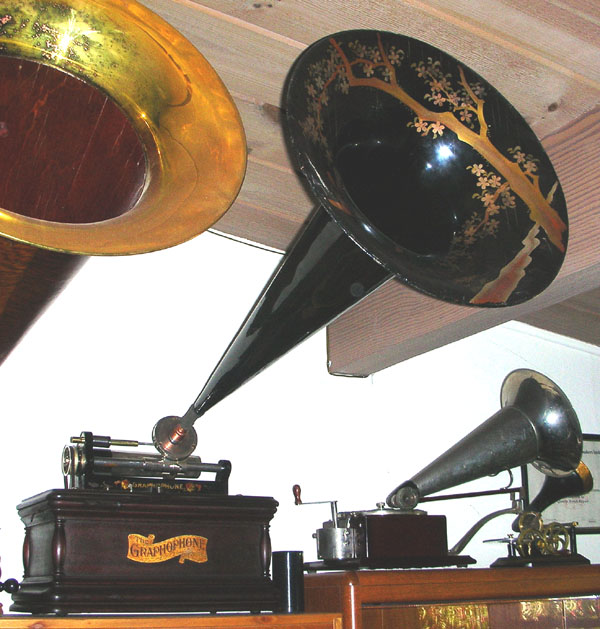

One of the most persistent quests in early phonograph technology was to increase
volume, but despite constantly improving recording techniques and larger horns, most
early phonographs could not play very loud. Gimmicks like the Polyphone
and the Double-Bell Wonder promised
twice the volume but couldn't deliver it. Prior to electrical amplification in the
1920s, there simply weren't many options available.
In fact, there were only
two successful forms of mechanically-augmented amplification in the early 1900s,
both nearly concurrent. One was the disc Auxetophone,
which used high pressure air flow through a valve reproducer to generate enormous
volume. In the cylinder camp, there was a friction reproducer invented by Daniel
Higham (pronounced "hi-am") which increased the vibration of a conventional
mica diaphragm by the mechanical action of an ebonite friction 'shoe' engaging a
rotating amber wheel. The technology was licensed by Columbia and used in the huge
and powerful Type BC Graphophone in 1905. It promised 16 times the volume of a conventional
reproducer. Although this was a typical exaggeration of the era, the fact remains
that it does play very loudly and with superb clarity.
The following year
Columbia introduced a slightly smaller version in an elegant mahogany case: this
Type BM, also called the "Home Premier." The motor has four springs rather
than six and the reproducer was reduced from 4" in diameter to 3", but
the sound volume (and quality) still rivals the larger Type BC. Priced at a very
expensive $75 -- nearly two months income for a salaried worker -- it was not very
successful in the market despite its high quality, elegant design, and exceptional
performance. Like the Auxetophone, it was perhaps just a bit too loud for home use.
The
BM was designed with a 6" long mandrel capable of playing Columbia's latest
innovation, the new "Twentieth Century" cylinders offering three minutes
playing time. These unwieldy records, aptly advertised as "half-foot",
never caught on with the public and were soon rendered obsolete by Edison's conventional
4" length Amberol recordings with grooves twice as fine, playing four minutes.
The
Type BM, with its clever but difficult to adjust Higham reproducer, is one of the
most mechanically fascinating of early phonographs and serves as an intriguing cylinder
counterpoint to the disc Auxetophone.
